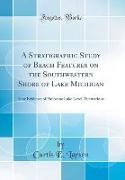- Start
- A Stratigraphic Study of Beach Features on the Southwestern Shore of Lake Michigan
A Stratigraphic Study of Beach Features on the Southwestern Shore of Lake Michigan
Angebote / Angebote:
Excerpt from A Stratigraphic Study of Beach Features on the Southwestern Shore of Lake Michigan: New Evidence of Holocene Lake Level FluctuationsThis study of a beach ridge complex along the southwestern shore of Lake Michigan provides new evidence of long-term trends in water level fluc tuations of Lakes Michigan and Huron that are not discernible in the short, 125-year historic record of measured lake level changes. Radiocarbon age control of lake terraces and other beach features provided by dates from buried peat and fossil wood indicates that during the past years lake levels were markedly higher and lower than present levels for periods on the order of centuries. This suggests that historically recorded levels, con sidered high by modern standards, may represent a relatively low cycle on a naturally fluctuating trend. Study results thus have important implications for engineers and hydrologists concerned with planning and construction along the lake shore.The established geological history of the Great Lakes region recognizes three prominent lake stages in the postglacial Upper Great Lakes~the Nipissing stage B. P. L, the Algoma stage and modern Lakes Michigan and Huron B. P. To present). The Nipis sing stage was initiated when differential isostatic uplift raised northern outlet channels above southern outlets, causing the lakes to rise and drain through preexisting late glacial outlets at Chicago and Port Huron, Michigan. Incision of the Port Huron outlet about B. P. Caused the levels of the lakes to drop to those of the subsequent Algoma stage, the Chicago outlet was abandoned. Renewed incision of the Port Huron outlet about B. P. Caused a final drop to the present level of Lakes Michigan and Huron.Results of the present study provide for a more detailed interpretation of these changes and indicate that conspicuous fluctuations of Lake Michi gan have occurred during the past years - a period previously recog nized as one of relatively stable levels. The Nipissing and the Algoma stages of the lakes have been defined here as high fluctuations of Lake Michigan separated by subsequent periods of low lake level. An earl y Nipissing stage fluctuation (nipissing attained an altitude of 783 m about b.p. A second Nipissing stage fluctuation (nipissing ll} reached an altitude of m about B. P. Temporal agreement with Holocene neog/acial and pollen records suggests that the Holocene levels of Lakes Michigan and Huron were climatically related to changes in water volume in these lake basins. Such fluctuations appear to have been superimposed on the dif feren tia/ isostatic uplift of the region and suggest that Nipissing and Algoma stage levels could not have been controlled solely by episodic incision of the outlet channel at Port Huron.About the PublisherForgotten Books publishes hundreds of thousands of rare and classic books. Find more at www.forgottenbooks.comThis book is a reproduction of an important historical work. Forgotten Books uses state-of-the-art technology to digitally reconstruct the work, preserving the original format whilst repairing imperfections present in the aged copy. In rare cases, an imperfection in the original, such as a blemish or missing page, may be replicated in our edition. We do, however, repair the vast majority of imperfections successfully, any imperfections that remain are intentionally left to preserve the state of such historical works.
Folgt in ca. 10 Arbeitstagen





